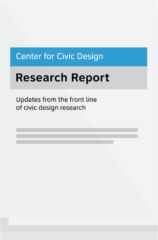Principles and guidelines for remote ballot marking systems
This project proposes principles and guidelines for the design and development of remote ballot marking systems, considering them in their entirety, including:
- The technical systems that make up a remote ballot marking system
- The accessibility features and communications needed to support all voters
- The election administration procedures to deploy a remote ballot marking system
We chose to work on remote ballot marking systems because they are a new addition to election options, but are similar to polling place ballot marking systems. They use new technology, and so also address how new technologies can be part of elections.

Principles and guidelines for remote ballot marking systems
Download reportKey findings
This project proposes principles and guidelines for the design and development of remote ballot marking systems.
For the purposes of this report, we defined a remote ballot marking system as:
Part of a voting system that allows voters to mark their ballots outside of a voting center or polling place. These systems allow a voter to receive a blank ballot to mark electronically, print, and then cast by returning the printed ballot to the elections office.
Principle 1: Trusted and transparent
Voters need to trust and understand how to use the remote ballot marking process in order to accept the results of the election.
Principle 2: Consistent with other voting options
The remote ballot marking option should not have special rules that make it inconsistent with the overall election process.
Principle 3: Access for all voters
Remote ballot marking systems can be used by all voters without discrimination.
Principle 4: Minimizes privacy and security risks
Remote ballot marking systems minimize privacy risks by carefully designing the use of personal information that can identify voters, throughout the system.
Principle 5: Supports accurate and secret ballot marking
Remote ballot marking systems support voters in marking their ballot without error, and protect the secret ballot.
Principle 6: Enables easy review, printing, and packing of the ballot
Remote ballot marking systems support voters in the activities such as review, printing, signing, and packing the ballot and related materials to enable the ballot to be cast when received at the election office.
Principle 7: Supports election administration procedures
Remote ballot marking systems support election officials in managing returned ballots for election integrity.
Principle 8: Tested for usability for all voters
Remote ballot marking systems meet performance standards for usability and accessibility for all voters.
Principle 9: Robust and reliable
Remote ballot marking systems are designed and maintained to ensure the integrity of the election.
About the research
This research was conducted by …. staff names with hyperlinks.
Input for this project came from a wide variety of sources, including the current general accessibility standards and the requirements for voting systems in the Voluntary Voting System Guidelines (VVSG 1.1) adopted in 2015, and two unpublished reports:
- A summary of current ballot delivery systems and remote ballot marking systems from the Verified Voting Foundation
- Draft recommendations for remote ballot marking systems provided by the National Federation of the Blind (included in the report appendix)
We also reviewed other reports on online election systems to understand the background and the kinds of issues reported about these systems’ security, accessibility, or usability.
We consulted with experts in election administration, technology, systems design, access for people with disabilities, and election integrity at a working meeting held on October 9, 2015 at the National Federation of the Blind. The full list of participants is included in the report.

